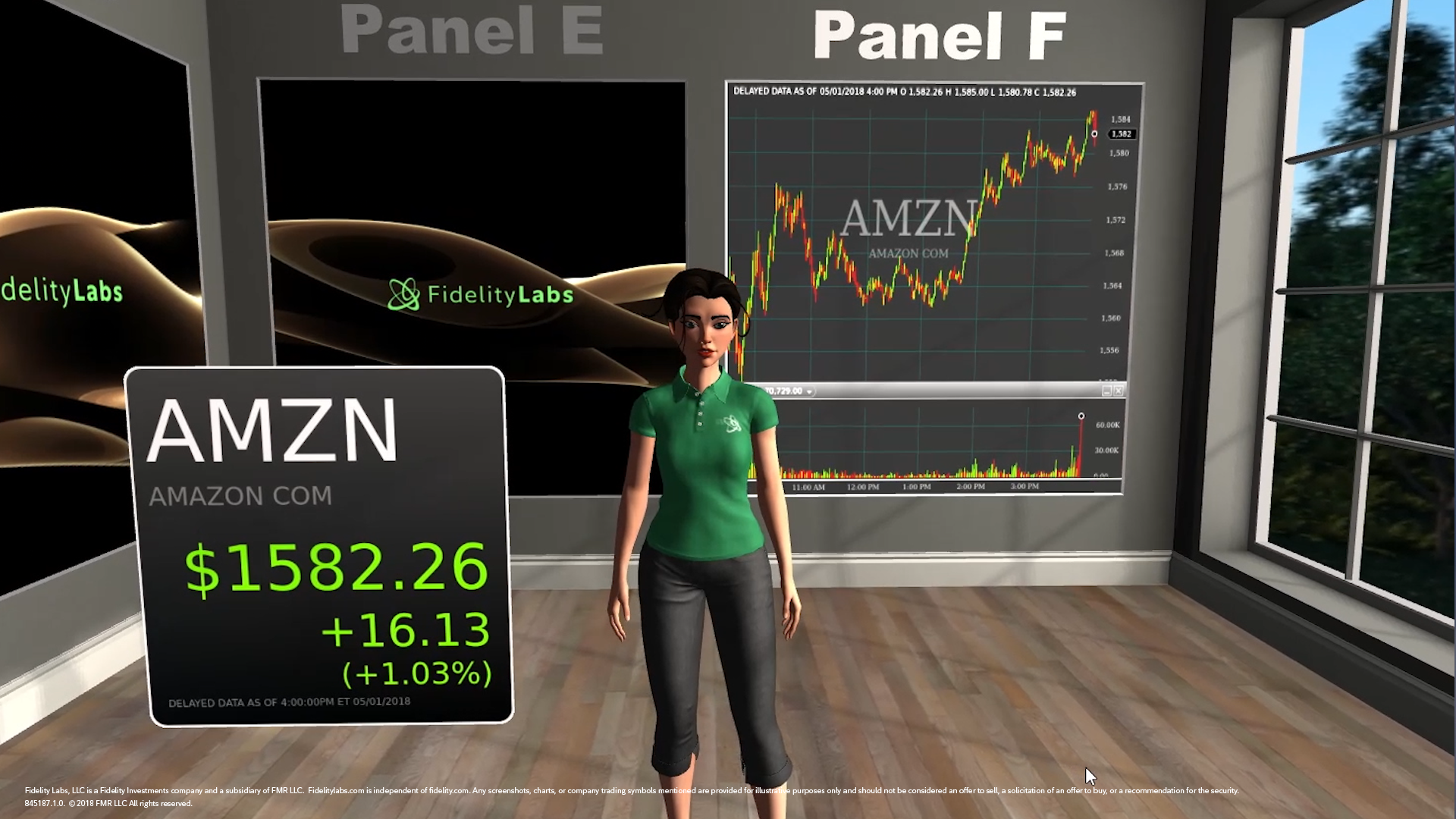 Meet Cora, your new financial assistant, who greets you as you enter a room filled with screens ready to show you the latest financial and investment charts.
Meet Cora, your new financial assistant, who greets you as you enter a room filled with screens ready to show you the latest financial and investment charts.
The room has no seats and no doors, but a large window looks out into a tree-filled landscape, while giant screens cover three of the room’s walls.
“Show me a graph,” you ask her.
“Which stock?” Cora responds.
“Amazon,” you say.
“The stock’s symbol is AMZN and the stock name is Amazon.com, Inc. – is this the stock you want to quote?” Cora asks.
As you respond in the affirmative, Cora brings up Amazon’s chart on one of the room’s giant screens, giving you instant real-time access to information about the stock and dialoguing about the stock’s most recent closing price and performance.
But Cora isn’t real, she’s a virtual reality manifestation created as a proof of concept by Fidelity Labs, the research arm of Boston-based Fidelity, using technological infrastructure from Amazon Web Services called Amazon Sumerian.
Combining virtual reality with voice recognition creates a virtual financial assistant that looks like a 3D animation of a woman but responds to spoken questions in real time. Cora’s “virtual chart room” is also a digital artifice that users can interact with via virtual reality goggles.
“This is one of the first times that we’ve seen these two things, virtual reality and natural voice processing, combined together, and we’re looking to explore whether this use case really works,” said Adam Schouela, vice president of product management and emerging technology at Fidelity Labs. “The idea of being able to use natural language processing to ask natural questions and get back answers both in speech and visually [is] it increases the speed in which you can get the information and answers you’re looking for.”
Cora uses Amazon Sumerian to combine virtual and augmented reality and 3D imaging applications with natural language processing like the type used in Amazon’s Alexa or Apple’s Siri.
Fidelity Labs felt that Amazon’s virtual reality and voice processing capabilities were a natural fit for each other.
“The voice component is very powerful when used within virtual reality. It’s difficult to type or use a controller with a virtual reality headset on because your eyes and your hands are otherwise busy,” said Schouela.
Cora is the first proof of concept on the Sumerian service. Fidelity Labs experiments with emerging technologies to see if they can find use cases relevant to financial industries. For example, Fidelity was one of the first institutions to design an application for the Pebble Watch, an early iteration of the smart watch. Fidelity’s experience working with the use cases and design principles for smart watch applications allowed it to be among the first to launch an application when more successful smart watches on Apple and Android operating systems came to market.
This time, however, some of the technology showcased by Cora and her virtual chart room are already in play. Fidelity uses VR technology similar to Cora’s to offer its client support staff empathy training.
“Our trainees will be in a call center where they put on a VR headset and take a call from a customer,” said Schouela. “When they find out what the customer wants them to do, the VR headset transports the agent virtually into the client’s home to see what the client’s setting is like. Then they return to the call center to handle the transaction. At the end, the VR headset takes them back into the client’s home to see the impact of the transaction on the customer’s life.”
Schouela says the training has increased customer satisfaction scores, and Fidelity is looking to expand and create new virtual reality training modules to validate the technology’s positive impacts.
Thus far, Schouela says Fidelity has found four use cases for virtual reality technology: employee training, data visualization and research like the virtual chart room, customer education and collaboration, both between Fidelity professionals and between professionals and their clients.
“Now that the technology is more accessible and creating virtual reality content is less costly, we have the ability to apply it to a lot of different scenarios,” said Schouela.
While technological investing and advice solutions like robo-advisors and chatbots are already proliferating across the financial industry, Cora is just a prototype–but she might portend a future where more sophisticated technology is able to serve investors with a wider range of services, including personalized financial advice.
Particularly of interest to advisors is the ability of a virtual assistant like Cora to help clients visualize their savings goals in real time and act as a personal financial coach in between annual or quarterly client meetings. Advisors may also be interested in using a digital, fully interactive setting like the virtual chart room for meetings.
“Imagine creating a space where multiple people are able to gather virtually and have richer interactions without having to travel to a branch or an office,” says Schouela. “This is a tool that could enhance the interaction between an advisor and a customer.”